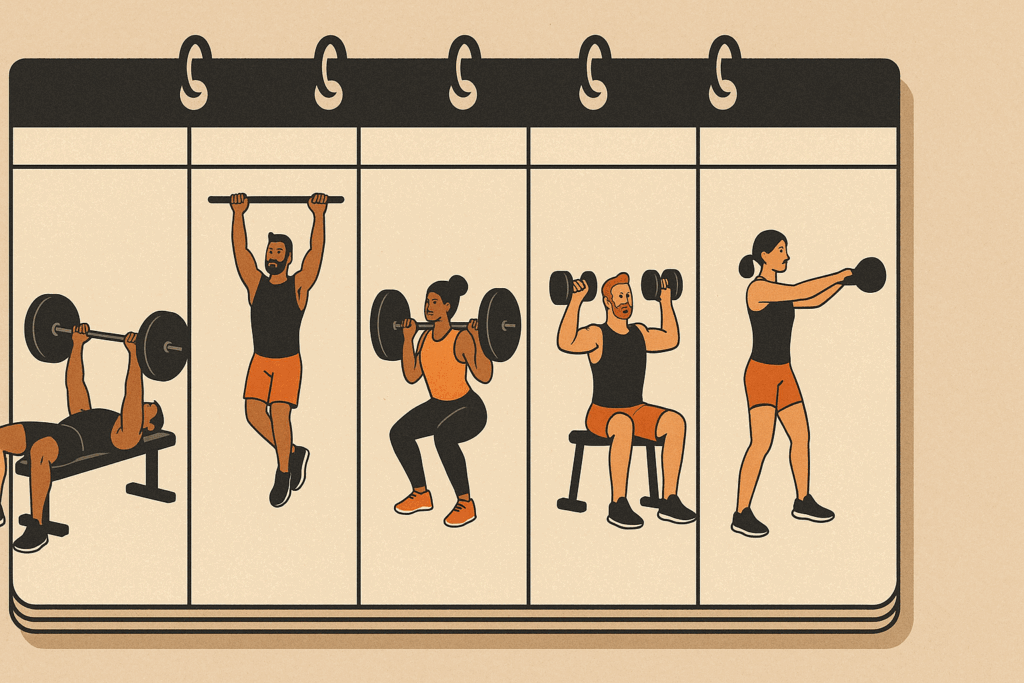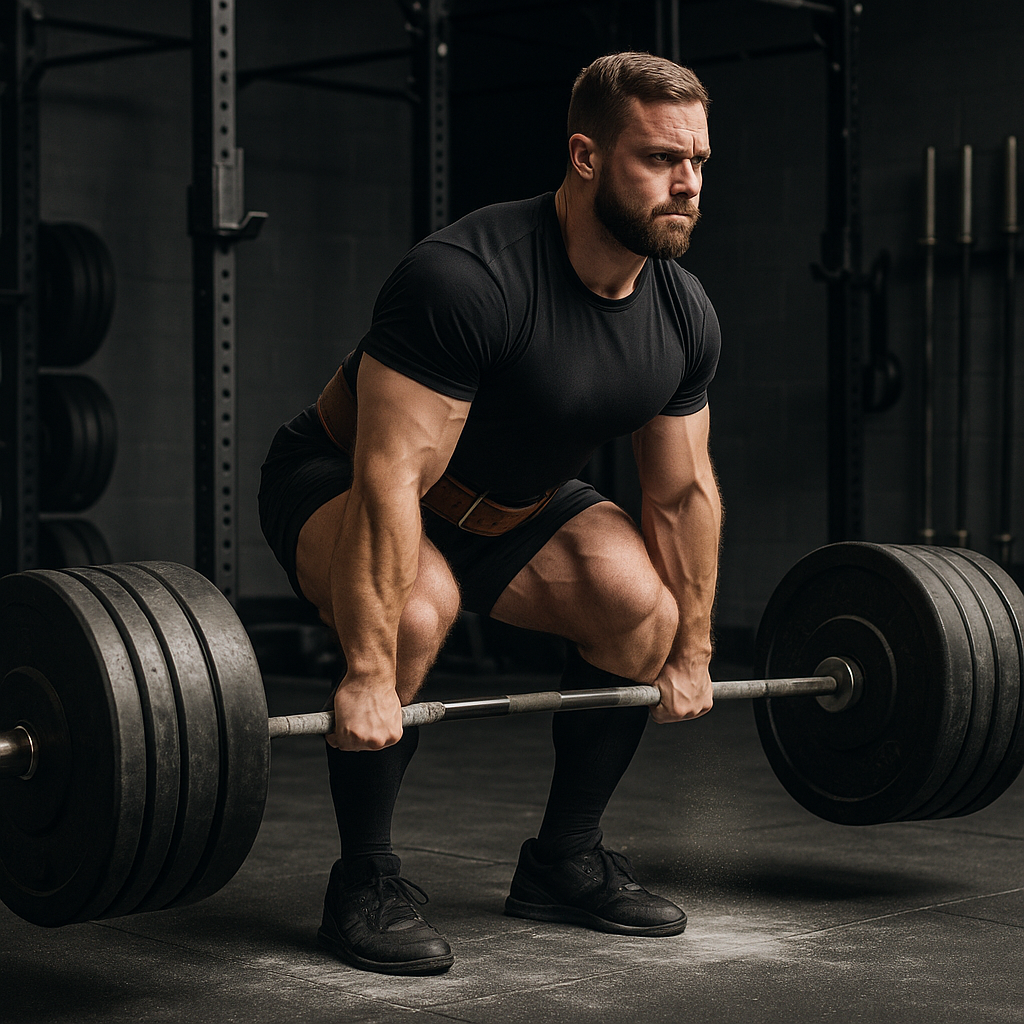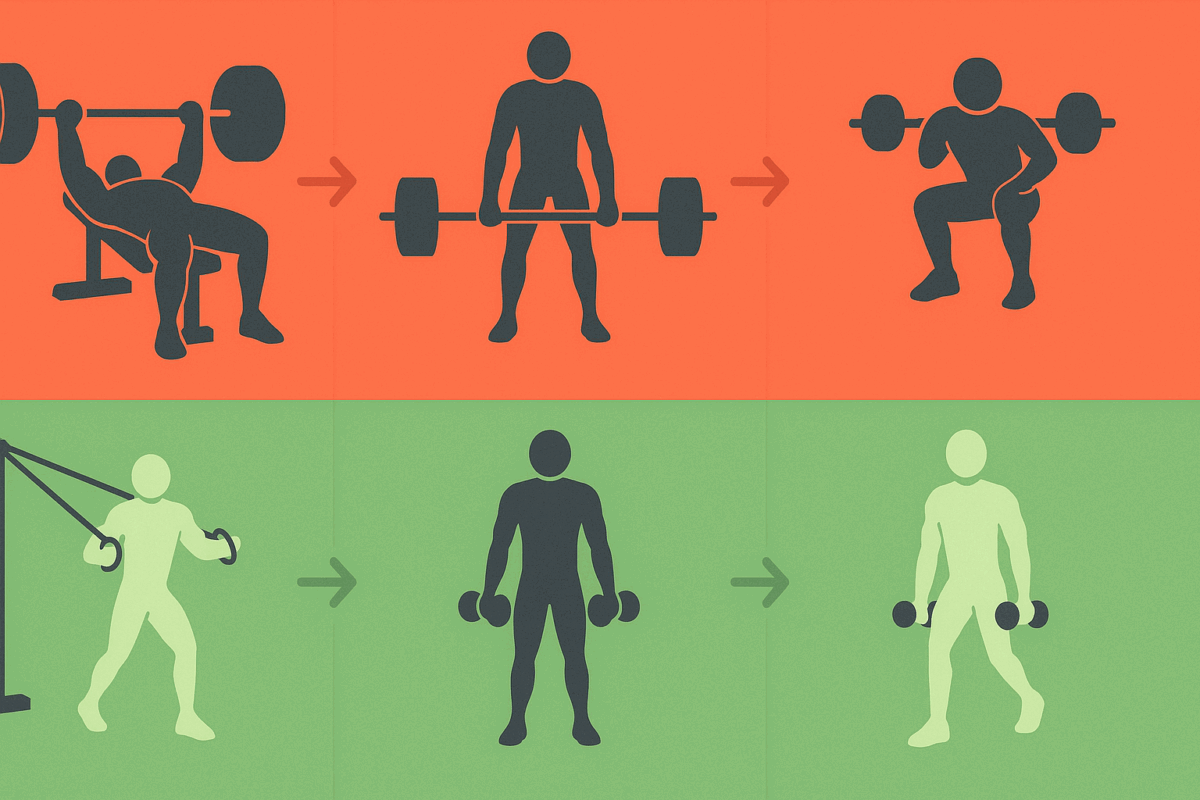Why Choose a 5 Day Split? Exploring the Science Behind the Structure
The foundational appeal of a 5 day split lies in its ability to target muscle groups with surgical precision. By dedicating specific days to different areas of the body, individuals can ensure each group receives both the volume and intensity necessary for growth. Research in exercise physiology supports the notion that increased training frequency—particularly when paired with sufficient recovery—leads to enhanced muscular adaptations. This method allows for higher total weekly volume compared to full-body routines, which often spread effort too thinly across multiple groups in a single session.

Moreover, a 5 day split aligns well with progressive overload principles. Since each session can be devoted entirely to a single or paired muscle group (such as back and biceps), individuals are better able to track and increase resistance over time without overreaching or risking fatigue spillover. This level of focus is especially important for compound lifts, such as deadlifts and squats, which require peak energy and concentration. Additionally, by spacing workouts across five days, lifters can benefit from increased mental engagement and less rushed sessions—critical for maintaining form and reducing injury risk.
There is also a psychological benefit to consider. Having a clearly defined plan reduces the cognitive load of deciding what to train, increasing adherence and motivation. The structure supports routine, which in itself is a powerful motivator. When paired with proper nutrition and recovery practices, the 5 day split becomes a reliable engine for measurable and sustainable progress.
You may also like: The Ultimate Hypertrophy Workout Program for Building Strength and Size
The Best Workout Split for Muscle Gain: Balancing Frequency and Recovery
Not all workout splits are created equal. While the 5 day split is often celebrated for its results, those results are only as good as the plan’s internal balance between frequency, intensity, and rest. One of the critical mistakes beginners and even intermediate lifters make is underestimating the importance of recovery. Muscle gains don’t happen in the gym—they happen between sessions, when the body is repairing and rebuilding tissue.
This is where the 5 day workout split for muscle gain stands apart from lower-frequency routines. By scheduling targeted sessions across the week, each muscle group can be worked hard once and then supplemented with synergistic engagement on other days. For example, a push day targeting chest and triceps will also indirectly stimulate the front deltoids. Later in the week, a shoulder-focused session will reinforce and extend the stimulus to those same areas, promoting both primary and secondary growth adaptations.
Importantly, this approach also allows for adequate rest days—either taken consecutively on weekends or staggered midweek depending on the trainee’s recovery capacity and lifestyle. By ensuring muscles are not overworked consecutively, the 5 day split maximizes both safety and effectiveness. Furthermore, it encourages strategic use of rest-pause sets, drop sets, and tempo work, all of which add metabolic stress to encourage hypertrophy without extending the risk of joint strain or overtraining syndrome.
When implemented with periodization and progressive overload, this type of training can dramatically alter an individual’s physique and strength profile in as little as 12 weeks. The results are not merely aesthetic—lifters report improved functional strength, better posture, and greater confidence in athletic and everyday movements.

Structuring the Ultimate 5 Day Workout Plan: A Sample Weekly Framework
Designing a 5 day workout plan requires thoughtful consideration of muscle synergy, fatigue management, and individual training goals. While there is flexibility in how days are structured, the following is a widely respected configuration that accommodates both beginners and seasoned athletes aiming for hypertrophy and strength:
- Day 1: Chest and Triceps
- Day 2: Back and Biceps
- Day 3: Legs and Core
- Day 4: Shoulders and Traps
- Day 5: Full-Body Power or Weak Point Training
Each day is purposefully paired to avoid overlapping major compound movements while still encouraging indirect activation of supporting muscle groups. For example, training chest and triceps together ensures that pressing movements like the bench press hit both muscle groups efficiently. Similarly, back and biceps benefit from pulling movements such as rows and pull-ups.
Leg day is strategically placed midweek to allow for sufficient energy stores and to break up the upper-body focus. This day not only targets quadriceps, hamstrings, and glutes but also introduces core work, which is essential for stability and injury prevention. Day four’s emphasis on shoulders and traps allows for pressing and isolation exercises to round out the upper-body frame.
The final day is often overlooked but plays a pivotal role in the best workout split for muscle gain. This can be structured as a power day involving Olympic lifts and explosive movements like cleans or snatches—or it can be dedicated to weaker muscle groups needing more volume, such as calves, forearms, or rear delts. This flexibility ensures that no muscle is left behind, and progress continues to move forward.

Maximizing Results with a 5 Day Bodybuilding Split: Hypertrophy-Focused Techniques
When the goal is aesthetics and muscle size, a 5 day bodybuilding split offers the perfect playground for hypertrophy-specific tactics. This is where time-under-tension, isolation movements, and mind-muscle connection techniques come into play. Unlike powerlifting routines that prioritize sheer load, bodybuilding routines emphasize the quality and control of each rep.
By breaking the week into specific muscle days, bodybuilders can ensure they are not only lifting heavy but also using a variety of rep ranges and tempos. Slow eccentrics, peak contractions, and advanced intensity techniques like supersets and rest-pause sets become more manageable and effective when the nervous system is not overtaxed by full-body fatigue. This allows for maximal engagement of muscle fibers, particularly Type II fibers known for their size and growth potential.
In addition, the split encourages variation in grip, angle, and exercise selection—important variables in preventing adaptive resistance. While a standard back workout might include deadlifts and rows, a more nuanced session might rotate in reverse grip pulldowns, one-arm dumbbell rows, and meadows rows to hit the lats and rhomboids from different angles. These variations ensure continued muscle stimulus and prevent stagnation, a common hurdle in long-term bodybuilding routines.
The bodybuilding community has long revered the five day split because it aligns so well with both their aesthetic goals and physiological needs. Muscle groups are given time to repair, the volume is sufficient to spark growth, and the structure allows for creative programming that keeps workouts both challenging and engaging.

Elevating Strength with a 5 Day Lifting Routine: Power Meets Precision
While bodybuilding focuses on aesthetics, many athletes prioritize functional strength as their primary goal. The good news is that a well-designed 5 day lifting routine can cater to both. The key lies in programming that incorporates both compound lifts and accessory work in a way that supports maximal strength development without sacrificing joint health or recovery.
A strength-focused 5 day workout program might rotate key lifts across the week: squat, bench press, deadlift, overhead press, and a dedicated day for Olympic-style or speed training. Each session begins with a heavy, low-rep compound movement—often in the 3 to 5 rep range—followed by supportive exercises designed to reinforce the primary movement patterns. For instance, a squat day would include front squats, Bulgarian split squats, and hamstring curls to provide both anterior and posterior chain engagement.
The beauty of a 5 day split in this context is the ability to recover adequately between heavy sessions. With each primary lift spaced out across the week, central nervous system fatigue is minimized while local muscular fatigue is managed through smart exercise sequencing. The result is a balance between strength progression and muscular hypertrophy—two goals that often seem at odds but are in fact highly synergistic when programmed correctly.
Importantly, strength-focused lifters can still benefit from hypertrophy techniques typically reserved for bodybuilders. Incorporating 8-12 rep accessory sets, paused reps, or tempo variations can help build tendon and ligament resilience, reduce injury risk, and develop balanced musculature that supports long-term performance.

5 Day Workout Split Each Muscle Twice a Week: Frequency Amplified
One of the more advanced strategies employed by high-level athletes is a 5 day workout split that targets each muscle twice a week. This method enhances frequency without compromising recovery by adjusting training volume and intensity across sessions. The split often involves a push-pull-legs structure followed by a second, lighter round of the same sequence. For instance, Monday might focus on heavy chest pressing while Thursday emphasizes higher-rep incline flyes and cable crossovers.
Scientific literature has shown that stimulating muscles more than once a week can lead to greater hypertrophy, especially when total weekly volume is equated. This is because protein synthesis typically peaks within 48 hours of a workout, suggesting that more frequent training may better sustain an anabolic environment. However, the key is managing fatigue. By cycling between heavy and moderate days, lifters can maximize adaptation while minimizing systemic exhaustion.
This version of the five day workout plan is especially popular among advanced lifters who have already built a solid base and are seeking marginal gains. It requires careful tracking of recovery markers such as sleep quality, resting heart rate, and mood. When managed correctly, the results can be extraordinary: greater fullness, faster gains, and improved muscle symmetry—all hallmarks of elite-level physiques.
Additionally, this variation opens the door for undulating periodization, where rep schemes change throughout the week to stimulate different types of muscle fibers. This adds complexity and challenge while keeping training fresh and goal-oriented. For lifters seeking maximum returns, this strategy represents the pinnacle of programming sophistication.

Navigating Plateaus and Fatigue in a 5 Day Fitness Plan
Even the best-designed plans can hit snags. Over time, the body adapts to stimulus, and progress stalls. Plateaus are a normal part of any serious training journey, but they can often be overcome by adjusting variables within your 5 day fitness plan. This may involve increasing training intensity, altering rep schemes, or incorporating new movement patterns to challenge neuromuscular coordination.
Fatigue management is another crucial consideration. While training five days a week is ideal for volume and frequency, it does require smart recovery strategies to avoid burnout. This includes adequate sleep, proper hydration, balanced nutrition, and periodized rest weeks or deloads. Many athletes benefit from a four-week progression followed by a week of reduced intensity to reset the central nervous system and prepare for the next training block.
Mental fatigue should not be overlooked either. Repeating the same exercises and split for months on end can lead to motivational dips and poor adherence. Swapping out key movements, altering rest intervals, or even adjusting the order of training days can bring a fresh perspective and renewed energy to the routine.
Ultimately, success in a 5 day gym routine depends on a combination of consistency, adaptability, and self-awareness. Tracking your lifts, monitoring recovery, and listening to your body are the best ways to ensure ongoing gains and reduced injury risk. Every lifter, regardless of experience level, benefits from periodically reassessing and adjusting their approach to meet evolving needs and goals.
Frequently Asked Questions (FAQ): Unlocking Deeper Benefits from Your 5 Day Split
1. How does the 5 day split enhance neurological adaptations for strength?
While most people focus on muscular hypertrophy when committing to a 5 day workout, the neurological improvements are just as critical. A 5 day lifting routine allows for repeated exposure to complex movements like deadlifts or overhead presses, reinforcing motor pathways. Over time, this leads to more efficient muscle recruitment and firing patterns—meaning your body gets better at lifting heavy even without visible size increases. This adaptation also sharpens coordination and stability, particularly for compound lifts in a 5 day gym plan. By rotating muscle groups intelligently, a 5 day gym split enhances neural recovery and reduces central nervous system fatigue, offering a smarter way to build lasting strength.
2. Can the 5 day workout routine improve mental health beyond physical transformation?
Absolutely. Committing to a structured 5 day fitness plan creates a rhythm that positively impacts psychological well-being. The act of showing up five days a week builds discipline, and consistent endorphin release combats anxiety and mild depression. A thoughtfully designed 5 day gym workout can also become a meditative practice, especially when performed solo and with intentional pacing. Moreover, the structure of a five day workout program gives people a daily sense of achievement, which is essential for mental resilience. The connection between brain health and movement is increasingly recognized in sports psychology, and a 5 day a week workout plan embodies this synergy.
3. What’s the long-term benefit of choosing a 5 day workout split over full-body routines?
While full-body routines have their place, the 5 day workout split for muscle gain offers cumulative advantages for advanced trainees. With a 5 day gym routine, you can push each muscle group harder without overlapping fatigue, allowing greater volume per session—a key driver of long-term growth. Over time, this promotes more muscle density and joint-specific resilience. Furthermore, a 5 day lifting routine allows for specialization phases where you can focus on weak points without compromising the rest of your development. The progressive overload embedded in a 5 day bodybuilding split better supports advanced periodization and peak physique sculpting.
4. How does a 5 day gym split support better metabolic conditioning?
A properly structured 5 day gym workout doesn’t just build muscle—it can also enhance your metabolic efficiency. Training five days per week increases total energy expenditure, even on rest days, due to elevated post-exercise oxygen consumption (EPOC). With enough intensity and volume, especially when legs and back are involved, the 5 day workout program can prime the body to become a more efficient fat-burning machine. Over time, this improves insulin sensitivity and reduces visceral fat. Incorporating circuit-style finishers within a 5 day gym plan elevates heart rate and keeps metabolism elevated for hours post-training.
5. How can I personalize a 5 day workout split each muscle twice a week?
Although most people follow a standard push/pull/legs rotation, you can tweak a 5 day workout split each muscle twice a week to suit your unique goals. For example, combining antagonistic supersets (e.g., chest and back in one session) allows for quicker recovery and denser training volume. You can also use strength-focused low-rep days early in the week and hypertrophy-based high-rep sessions later to maximize both adaptations. For lagging muscles, like calves or rear delts, micro-sessions added post-workout ensure extra attention. A flexible five day workout plan lets you adjust frequency and intensity while maintaining progression over time.
6. What role does intra-workout nutrition play in a 5 day bodybuilding split?
Intra-workout nutrition becomes increasingly important in a demanding 5 day gym routine. As sessions grow in intensity and volume, especially during leg or back days, glycogen depletion can hinder performance midway. Sipping on a blend of fast-acting carbs and essential amino acids helps sustain energy levels and minimizes muscle breakdown. For those training in a fasted state or with limited recovery windows, intra-workout support becomes even more crucial. Over the course of a 5 day workout plan, proper fueling ensures consistent output and long-term muscular adaptation.
7. Is the 5 day split ideal for recomposition goals?
Yes, when paired with strategic nutrition, the 5 day workout split is an effective tool for body recomposition—simultaneously losing fat and gaining muscle. Its frequent muscle stimulation combined with high-volume training makes it superior to lower-frequency programs for maintaining lean mass during calorie deficits. If you tailor a 5 day workout routine with both hypertrophy and metabolic conditioning elements, you create a strong recomposition environment. Moreover, having five training opportunities per week allows you to manipulate intensity and recovery to meet both goals without overreaching. The balance of push, pull, and leg days in a 5 day gym plan gives you structural integrity and metabolic leverage.
8. How can women benefit uniquely from a 5 day workout routine?
Women can leverage a 5 day workout program not just for aesthetics but for hormonal and functional gains. Regular resistance training in a five day workout enhances bone density and improves metabolic rate, both of which are particularly important for women as they age. The flexibility of a 5 day lifting routine allows women to focus on glute and core development—common goals—while still supporting upper body strength. In addition, the hormonal response from consistent training helps regulate estrogen and cortisol levels, contributing to better mood and menstrual health. A 5 day a week workout plan empowers women to train with intention and control their progress in a sustainable way.
9. What are some lesser-known periodization techniques within a 5 day gym plan?
One overlooked strategy in a 5 day gym split is undulating periodization, where intensity and volume vary day to day instead of week to week. This method prevents plateaus and overtraining while keeping workouts mentally engaging. Another technique is “cluster training,” where intra-set rest allows for more reps at heavier loads—perfect for building both size and neural capacity. You can also implement velocity-based training to gauge recovery and readiness, adjusting the 5 day workout routine based on bar speed. These advanced tactics elevate your 5 days gym workout routine from conventional to elite-level programming. Periodizing properly keeps your gains consistent and your CNS healthy.
10. How will recovery protocols affect my success on a 5 day fitness plan?
A 5 day workout plan is only as effective as your recovery strategy. Delayed-onset muscle soreness (DOMS), sleep quality, and hydration all influence your capacity to maintain intensity throughout a 5 day lifting routine. Using tools like contrast therapy, foam rolling, and magnesium supplementation can accelerate recovery between sessions. Furthermore, tracking heart rate variability (HRV) or subjective fatigue gives you actionable insight to modify your training load if needed. Ultimately, pairing a five day split with optimized recovery techniques ensures that your muscle fibers are not only breaking down effectively—but rebuilding stronger every week.
Conclusion: The Best Workout Splits for Muscle Growth Begin with Structure and Sustainability
The journey to strength and muscular development is not linear, nor is it achieved through random workouts or short bursts of motivation. A structured approach—like the proven 5 day split—offers the strategic foundation necessary for long-term success. Whether your goal is to increase power, gain size, or improve overall fitness, this model provides the flexibility, precision, and consistency needed to thrive.
From advanced hypertrophy strategies to functional strength protocols, the 5 day workout plan adapts to suit a wide range of goals. Its balance of training volume and rest fosters an ideal environment for growth, while its adaptability ensures relevance through every stage of your fitness evolution. The best training split to build muscle is the one you can follow consistently, and few structures offer as much promise as this focused, sustainable, and scientifically supported plan.
By integrating intelligent periodization, recovery management, and progressive overload, a 5 day gym workout routine transcends trend and becomes a tool for lifelong fitness. Whether you’re crafting a 5 day gym split for aesthetics, performance, or both, remember that commitment and smart programming are your greatest allies. Stick to the plan, listen to your body, and the results will follow.
Further Reading:
A 5 Day Workout Split For True Beginners





